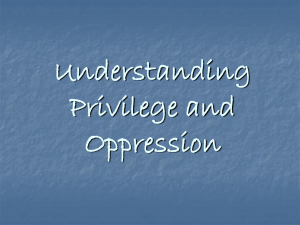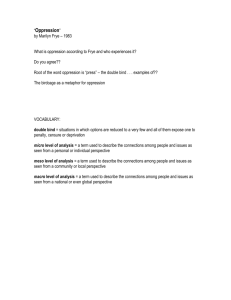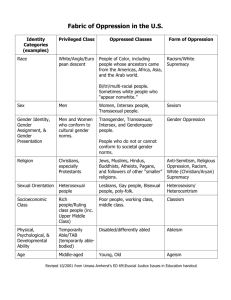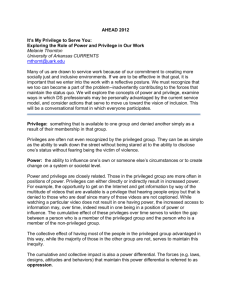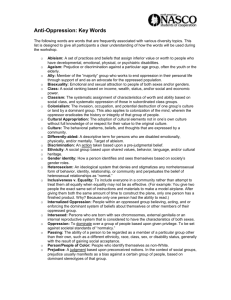of the session - Reclaiming Futures
advertisement
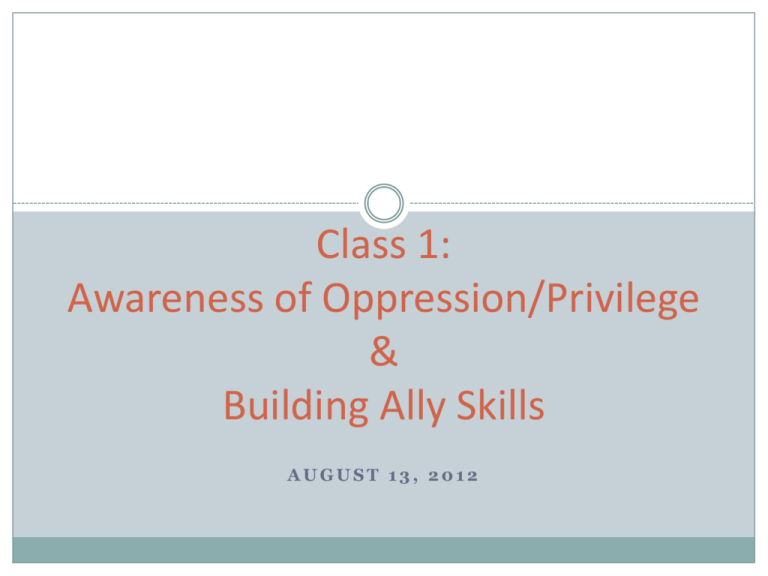
Class 1: Awareness of Oppression/Privilege & Building Ally Skills AUGUST 13, 2012 Objectives To deepen our understanding of dynamics of oppression and privilege Understand insidiousness of such dynamics (through experiential exercise) Practice interrupting oppression and privilege when we encounter it Make the links of this content to own site of practice Build core competencies for AOP-informed selfawareness and engagement Core Competencies 1. Awareness of context in the following areas: 2. 3. 4. 5. 6. Self-awareness as embodied and socially located The issues challenging this community today and in history The larger discourse issues that influence how we understand people and their difficulties Practice of deep self-reflection Building lifelong commitments to unlearning racism & dominance Ally skills Methods to interrupt oppression Noting impact of this work on your family, social and work circles Overview of today Pre-session review Learning the local context Reading materials At minimum, review data from Burns Institute on your state’s DMC data, looking at history of disproportionality in different areas. http://www.burnsinstitute.org/state_map.php. Ideally, review poverty data for region for groups of different race & ethnicities and compare with 5 years ago Morley – Teaching critical practice: Resisting structural domination through critical reflection Tatum – The complexity of identity: “Who am I?” Kirk & Okazawa-Rey – Identities and social locations: Who am I? Who are my people? Ayvazian – Interrupting the cycle of oppression: The role of allies as agents of change Review of key elements of AOP webinar Introduction to the AOP model as applied to Reclaiming Futures Introduction to the triangle tool – an analysis tool Presentation on dominant discourse Presentation on ally skills & interrupting privilege Activity on interrupting privilege Assign homework Complete sensitivity tools where you hold a privileged identity Review of Webinar Conflict perspective – power imbalances at root of distress Accounts for distress much better (and in non-blaming ways) than psychosocial models Multi-level manifestations and multi-level interventions Better explain disparities Counter-cultural lens… this is a hard sell, particularly in the justice field AOP as applied to the RF context Service fragmentation… who wins & who loses? The more money is wasted and the more people are hurt More money expended Services that are not designed for the people who are service users Our services are classed and raced (white, middle/upper class) Avenue of social control rather than social change Compliance and silence instead of liberation and increased entitlement to voice and Key Elements of Self-Awareness • Influences our ability to empathize & understand • We will focus today on privilege (as opposed to oppression) • We are all socialized to be (dare I say it?) racist, classist, sexist, homophobic, ageist – Need to perpetually “unlearn” the isms and know it is a lifelong task • We hold positional power (as workers in services) that reinscribes dominance over clients and communities – So need to be aware and have practices to moderate our power • While the behaviors may not be as durable or far-reaching as systems change work… • How we treat people matters! • There is one view (from Foucault) that says we reproduce or resist domination in every encounter – so every interaction is an avenue for resistance Triangle tool (Focus of today) (Focus of other classes) (Focus of today) Introduction to Dominant Discourse Equated with the “powerful ideas” on Triangle Tool Synonyms = ideology, socialization, myths Definition = set of meanings, images and/or statements that work together to construct who people are, without saying much Not usually intentional but so “commonsense” that it is not challenged Function Limits who we are and who we can be Prescribes being “normal” via defining insiders and outsiders Serves to reproduce dominance Examples Femininity constructed via “pink” Masculinity constructed by “manly” Reflections on Dominant Discourse What is reproduced in the image? How is the colonizer portrayed? How are the colonized portrayed? How is Christianity portrayed? What is portrayed of the relationship between the two? Is this image a dominant one? What is the impact of images & texts like this? That one was easy… let’s take on something harder… What dominant discourses are in photo? What do you notice about the picture? How is motherhood constructed? How is female constructed? How is it gendered, raced, classed, aged and sexually oriented? What norms (or “normativity”) is reproduced here? What is your experience if you are outside these norms? What is the consequence of hanging this photo (or equivalent image) in a battered women’s shelter? What happens to the culture of the organization? What if this impact is not intended? (“it’s just a nice picture!”) In the AOP framework, the impact is what matters Important because we don’t have to prove motivation in order to take the issue seriously Significance of disproportionality in our systems is what matters – we don’t have to slide into proving what someone intended, just that the impact exists One benefit is that in interrupting such dominance, we can presume intention did not exist. We can simply suggest that the impact exists, and bypass the issue of intention. People prefer to have the best presumed about them, rather than the worst. What about discursive language? “The smell of urine was in the hall.” “The client was late for 3 sessions in a row.” “Amanda denies using cocaine.” “This is an at-risk client.” “Carlos comes from an intact family.” Other examples? Most insidious impact? It plays a significant role in the reproduction of the status quo and the power held by the privileged This is a vehicle for the privileged to justify their power Because we have dehumanized and rendered the oppressed in a one-down space as one of inferiority Lets the privileged bypass the immorality of their superiority, letting them ignore cognitive dissonance of injustice of superior/inferior systems Even lets the privileged take on the savior role as one of civilizing, helping and placating the oppressed What is the impact on social services here? Discussion: How does dominant discourse show up in RF sites? Added features? How is the service itself constructed? Innocent “Helping” in untroubled manner Beyond reproach If clients complain – being “ungrateful” or “oppositional” If staff complain – being “duped” or “bleeding heart” Anti-Oppressive Ally Skills Work through resistance (yours and others) that shows up in many forms “That all happened a long time ago – don’t blame me.” “I’m not racist (or sexist or classist).” “I’m a good person – I’ve never done anything nasty to someone who is struggling. So don’t blame me.” “I have friends who are oppressed.” “I don’t see people as black or white; I see them all as part of the human race.” Ally practices Assume racism (and other forms of oppression) is everywhere, everyday. Be a worker in your own liberation struggle. Work to end oppression when you experience it. Help members of your own group understand oppression. Listen and reflect. Listen some more. And then listen deeper. And again. Recognize that being a member of an oppressor group does not make you bad. Remember that being privileged means you can’t know what it is like to be oppressed. Assume that you don’t understand or don’t understand enough. Count your privileges and help others see their privilege too. Break the invisibility of privilege. Applies across identities including as person of color who holds privilege of class or status Speak up when you see or hear oppression in action. More ally skills When working in solidarity with the oppressed: Work in service of their leadership and their empowerment Don’t assume that you know what is best for them. Never take public credit or attention for their process. Don’t expect the group to easily agree – no group does. Don’t expect them to reward you for your efforts. They need energy for their struggle. Learn everything you can about the oppression. Don’t drain their resources on your education. Work with your own privileged group to learn about oppression and support each other. It takes hard work to be in sincere relationships with the oppressed. Don’t give up. Be yourself. You will carry the burden of your identity. Look for good role models. Deal with your emotions. This is difficult work. Be really honest with yourself. Find someone to work through the hard times. What people of color say they want from whites Respect us Find out about us Don’t take over Provide information Resources Take risks Don’t take it personally Understanding Teach your children about racism Speak up Don’t be scared by my anger Listen to us Don’t make assumptions Stand by my side Don’t assume you know what is best for me Money Make mistakes Honesty Talk to other white people Don’t ask me to speak for my people Support Your body on the line How to interrupt oppression Confront the behavior Not doing so serves to sanction & perpetuate the actions Silence is complicity Methods Express your disapproval of the behavior… assert yourself Interrupt and educate, explaining what is oppressive about the behavior Support the proactive responses of others (that promote understanding of differences & take action to promote understanding) Initiate a proactive response that allows you to work for change more widely & directly Extending your intervention... On Graceful Interventions Please aspire to the following To notice and interrupt To educate as opposed to shame To believe in the possibility of learning and transformation (or else why are we doing this?) To accept apologies To enter such engagement with grace To be willing to hold ourselves complicit as well To bracket self-righteousness To occupy a stance of humility for all the work we still have to do To love and to exhibit love, compassion & forgiveness And to be gentle & forgiving with yourself, for these are aspirations that we are rarely likely to attain! Practicing Interventions You listen to a customer give a cashier a hard time – she says, “I can’t understand you. Why don’t you learn English?” As you walk past an intake room, you hear the worker utter an “uugh” as she hears the customer confirm he is in a homosexual relationship. Your brother says: “She’s getting pregnant just so she can get welfare.” “Can’t you take a joke? Ever since you took that training program, you’re no fun to be around.” Homework and follow-up: Sensitivity Tools Race Video of “A girl like me” can be viewed on your own at the following site: http://www.mediathatmattersfest.org/watch/6/a_girl_like_me. Unpacking a lifetime of white privilege (in pre-reading for the course) Class Money & raising children Age Adultism tool Gender Sexism & male dominance Positional privilege On being the boss
